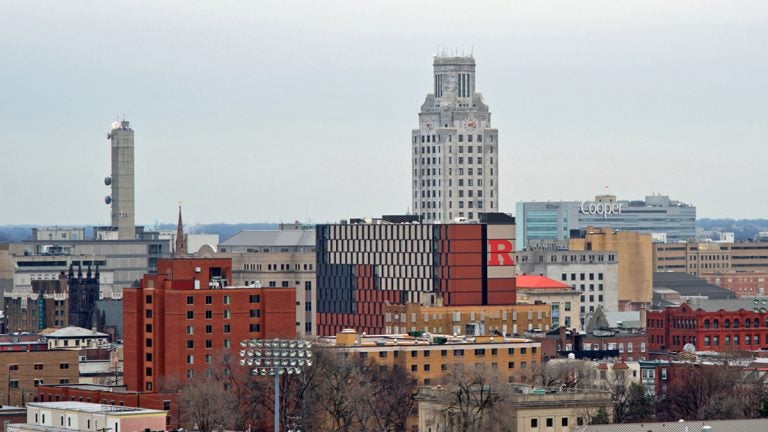Commentary: Camden’s reputation is on the rise but will the city follow?
Listen
Camden New Jersey (Bas Slabbers/for NewsWorks)
So, Subaru is coming to Camden. The headlines keep getting better. Camden’s image makeover has been dramatic. You don’t have to go back that far to remember when every story felt like the city’s obituary.
A year ago Rolling Stone’s Matt Taibbi provoked Camden boosters with his over-the-top damning critique of the city’s new, county-based police system.
A robust public relations campaign followed to counter the bad effects of the best-selling author’s assessment. Mostly the essays were local, but on Labor Day, such testimonials ascended to a new level when the New York Times’s Kate Zernike wrote a glowing front-page review of politically-driven changes to Camden policing.
A host of feel-good stories followed in Zernike’s wake, including NBC’s Brian Williams’ September 26 broadcast from the USS New Jersey on the Camden waterfront.
It gets better. Camden, thanks to a technicality, will no longer be called the nation’s most dangerous city. Now that Camden’s police force is a regional police force (that only patrols Camden City) it doesn’t meet the criteria of the national City Crime Rankings.
Now The Financial Times has weighed in to suggest that Camden’s civilian-friendly approach offers a lesson for the nation shocked by police tactics in Ferguson and New York City that resulted in the deaths of black men.
The perception that Camden has finally transcended its reputation as a broken city is supported by a stream of news reports that not just public safety but employment prospects may be picking up with the inducement of a string of corporate moves to the city by generous tax incentives under the state’s Economic Opportunity Act.
Camden Redevelopment Authority director Saundra Ross Johnson is one of those people who think Camden is at a rare moment of opportunity when decades of decline can actually be reversed. She points, among other things, to neighborhood revitalization in the area adjacent to Cooper Hospital and to the boost the Kroc Center in Cramer Hill has given the whole city.
Clearly, there are many reasons to be skeptical. The translation of corporate tax credits into employment for Camden’s many currently under- or unemployed residents will not be easy. In the early 1980s, the state rationalized a prison on the city’s waterfront that represented a huge detriment to the adjacent North Camden neighborhood by citing its capacity for new employment. Most of the local residents who got those jobs left the city.
Even with the latest news that Subaru, should it receive the $118 million in tax breaks it is seeking from New Jersey, will consolidate its facilities in Cherry Hill and Pennsauken in a new office park where the Sears Building once stood just off of Admiral Wilson Boulevard, it’s hard to see any boost to Camden residents either in employment or amenities.
There’s little doubt that the city feels safer at the moment than it has in the past few years. Still, murder rates are unpredictable. What seemed like a really good year some months ago looks less promising as the number of murders climbed recently. Gang warfare could spike that number almost any time.
The fact is that poverty remains unacceptably high and concentrated in Camden’s most beleaguered neighborhoods. Terrific programs–for kids, for community development, for innovations in health care—which have been in place for some time have not been enough to significantly change conditions that remain anything but desirable.
A positive image is certainly preferable to a negative one. Years ago, Camden reeled when Time ran a story under the headline, “Who Could Live Here?’ Now that the flow of news is more positive, more people may choose to venture into the city, possibly even to live there and not just visit.
But it will take more comprehensive (and more transparent) action in the years ahead to gain the trust and commitment of stakeholders in the effort to move the city to a higher level of stability.
When asked recently about the new resources being directed to the city by Governor Christie, an astounding 68 percent chose the answer “Christie is doing this not because he cares what happens to Camden, but at the behest of Democratic powerbroker George Norcross. This is simply transactional politics. It would be nice if it works but I wouldn’t bet on it.” Only 13 percent replied that Christie was getting the policy right in Camden.
Skepticism can be overcome with results. Let’s keep an eye not just on crime statistics, but on the number of new jobs and who is filling them. Let’s see whether planned demolitions in some of the city’s poorer neighborhoods result in better housing conditions or in simply fallow land. And let’s continue to look beyond the headlines to ask in what ways current policies narrow the gap between the city of Camden and surrounding jurisdictions.
Good news is not to be scoffed at, but it must stand the test of time.
Other essays on Camden by Howard Gillette:
In representing Camden crime, let’s set the picture straight
‘Manhattanizing’ Philadelphia could help make Camden the next Brooklyn
_______________________________________________
Howard Gillette is author of Camden After the Fall: Decline and Renewal in a Post-Industrial City and is professor of history emeritus at Rutgers Camden.
WHYY is your source for fact-based, in-depth journalism and information. As a nonprofit organization, we rely on financial support from readers like you. Please give today.




